The Immune Response: A Cellular War
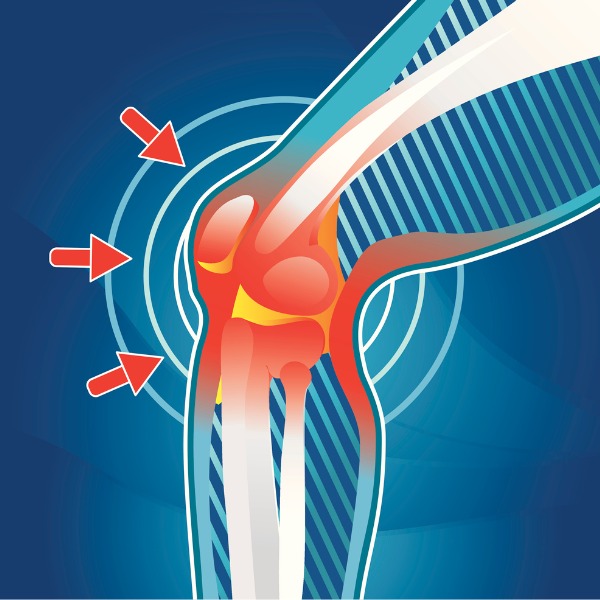
Inflammation of the knee (Bastun, iStockphoto)

Inflammation of the knee (Bastun, iStockphoto)
How does this align with my curriculum?
| Grade | Course | Topic |
|---|
An inflammatory response is your body’s attempt to fight invaders. Learn how your body springs into action when attacked!
Have you ever wondered why your skin turns red if you get a scrape or a mosquito bite? Or why your joints hurt when you have a fever? These are all symptoms known as inflammation.
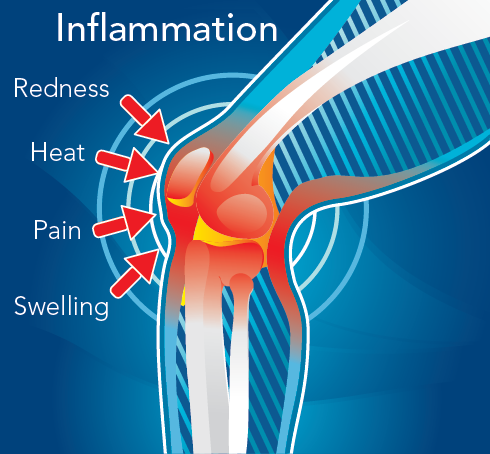
Inflammation is an example of your immune system at work. Your immune system keeps track of your self cells. Those are the cells in your body that are supposed to be there. It also recognizes non-self cells.
The body recognizes non-self cells because they contain antigens. Antigens are typically proteins on the surfaces of cells. Antigens can also be substances like toxins or foreign particles like splinters. Your immune system will immediately try to fight these intruders by starting an immune response. That’s when your various white blood cells team up to fight the invasion.
Did you know?
Your skin is part of your immune system. It’s an important barrier against foreign invaders. But if your skin breaks, bacteria can enter your body -- even when the break comes from something small, like a splinter!
What happens during an immune response?
Have you ever read about ancient battles in history or English class? You may recall how the people in a castle would work together to fight off invaders. That’s a little like what happens during an immune response. Imagine your body is like your kingdom. You have castles spread across it to keep you safe. But what happens when there is an invasion?
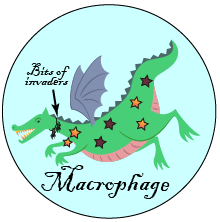
It helps if your castle has a helpful dragon. A dragon that protects the castle is like a macrophage. Macrophages are specialized white blood cells. They recognize invaders, then engulf and destroy most of them. Sort of like when a dragon eats the enemy. But macrophages keep tiny pieces of bacteria from the invaders and carry them around. This way, the other cells know an invader is on the loose. It’s kind of like a warning sign!
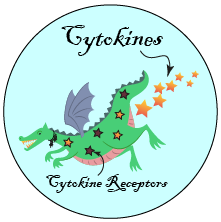
As the macrophage engulfs the invader, it releases inflammatory substances called cytokines. The cytokines bind to receptors on other macrophage cells. They fit perfectly into these receptors, like keys in locks. This is how macrophages communicate with each other. The cytokines tell other macrophages that an intruder is on the loose. This way, the whole team of macrophages know they need to destroy the invaders if they encounter them.

Macrophages are extremely useful. But they can’t destroy all invading bacteria. For additional help, the macrophages travel to your body’s lymph nodes. Lymph nodes are your immune system’s information centres. We have 500-700 of them and they spread all over our bodies.
Lymph nodes are kind of like the throne room of the castle. There, macrophages bring information about the invaders to white blood cells called lymphocytes. They let the lymphocytes know it’s time for an immune response. There are two types of lymphocytes. They are called T-cells and B-cells. These are like knights.
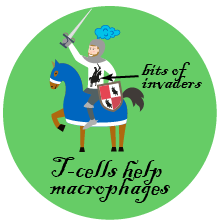
Remember the tiny pieces of bacteria the macrophages carry around like warning-posters? T-cells are able to recognize these. The T-cells will bind to the bacteria pieces and become activated. Once activated, the T-cells will begin to divide. Soon, your body has a large enough supply of these cells. Like an army of knights ready to fight, this supply moves toward the inflammation site. There the T-cells will help the macrophages to destroy the invaders.
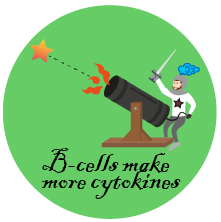
The B-cells also multiply. They help to make more cytokines which bring over even more macrophages.
This immune response continues until all of the invaders have been destroyed. Remember that all the cytokines being produced in this battle are inflammatory. So the part of the body where the immune response is taking place may be swelling, or turning red.
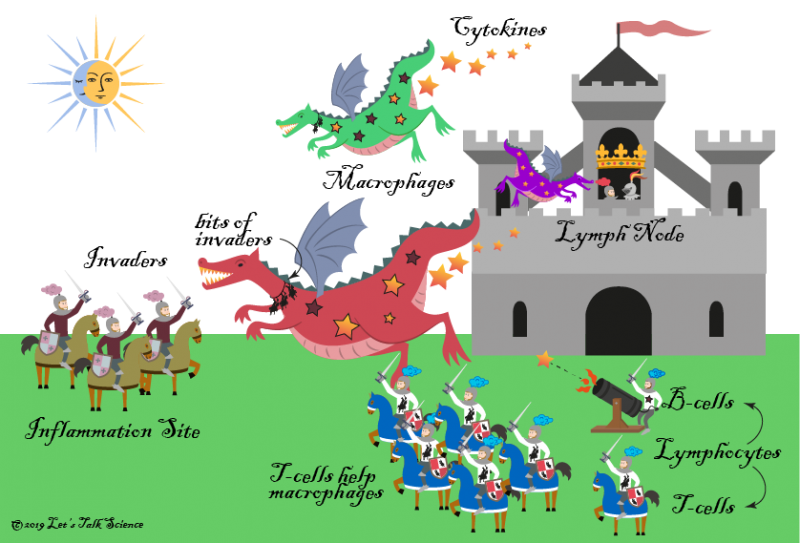
What is an autoimmune disease?
Ideally, an immune response like this only happens when bacteria or viruses invade your body. But this isn’t the case for all of us. Some people have autoimmune diseases. These are diseases where your body’s immune system mistakes self cells for non-self cells. So, the body of someone with an autoimmune disease launches the same immune response for self cells as it does for non-self cells.
Why is this a problem? Well remember, the immune response should stop once the invaders are gone. The swelling and redness should go away. But your body is always producing new self cells. What do you think happens if your immune system thinks all these new cells are invaders? That’s right - the immune response does not stop. Doctors call this chronic inflammation. Chronic inflammation can cause damage to healthy cells and tissues in the body.
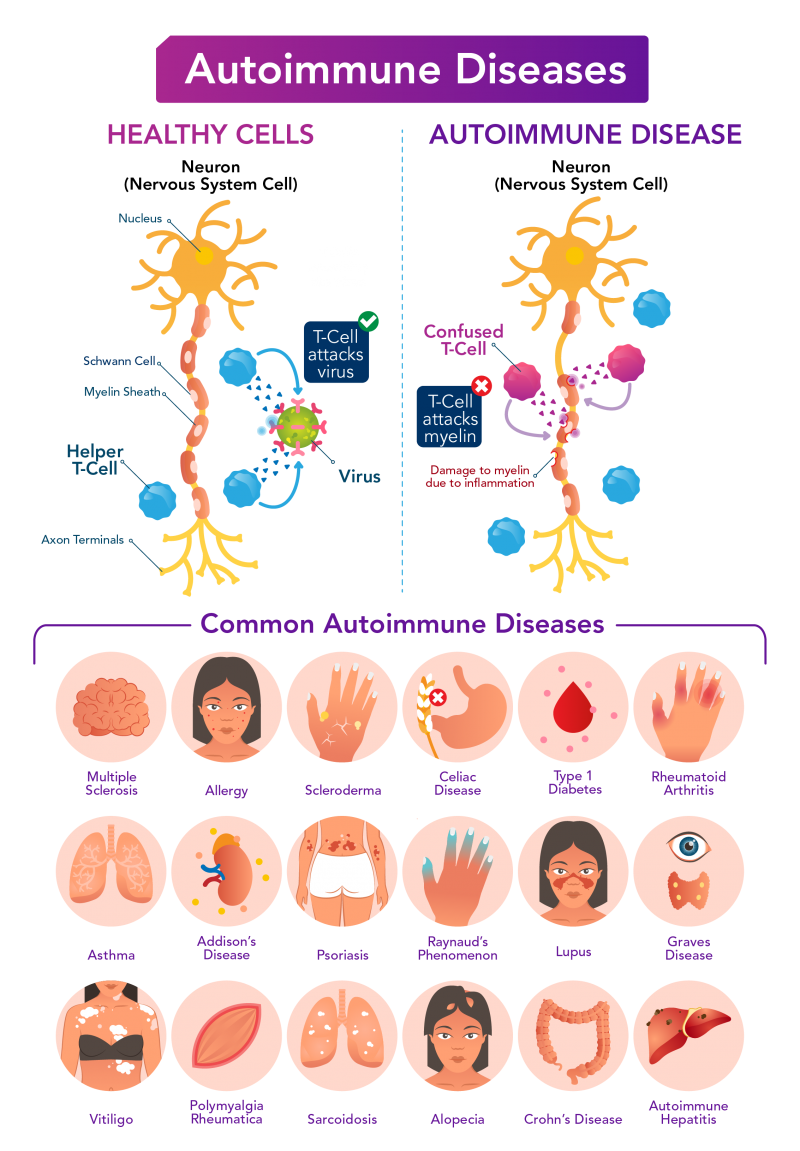
The body’s immune response is helpful when you encounter foreign bacteria that might be harmful. But it can be very dangerous when your immune response isn’t working properly, like when an autoimmune disease is present. Luckily, there are ways to manage many inflammatory responses and autoimmune conditions. Doctors might recommend changes to diet, medication or a combination of both to help people with these conditions to feel better.
Starting Points
- Have you ever had a mosquito bite or a bee sting? How does your skin look at the site of the sting or bite? How are the sensations of these bites or stings similar or different?
- Have you ever gotten a sliver or accidentally stepped on a tack? What did you do about it? How did your skin react?
- Can you tell when you are catching a cold? What physical symptoms do you experience when you are getting sick with a cold?
- It has been said that our modern Western world is “too clean” and that our immune systems do not get enough “exercise”. What do you think this means? Do you agree? What role has science and technology played in creating a “too clean” world? Explain.
- How can autoimmune disorders impact society?
- What is a “non-self cell”? What are some examples of non-self cells?
- Briefly explain an inflammatory response. Why is it important for immunity?
- What are cytokines? What role do they play in immunity?
- What happens in our lymph nodes? What two important lymphocytes are activated here?
- Biologics are a newer form of pharmaceutical (drug) therapy, introduced within the last decade, that is providing relief for people suffering from autoimmune disorders, such as rheumatoid arthritis, multiple sclerosis and Crohn's disease. Investigate how these medications are helping people with autoimmune disorders.
- This video and article support teaching and learning of Biology, Anatomy and Health related to the immune system and autoimmune diseases. Concepts introduced include immune system, self cells, non-self cells, antigens, immune response, cytokines, lymphocytes, T-cells, B-cells, autoimmune diseases, chronic inflammation, psoriasis, multiple sclerosis, inflammatory bowel disease and rheumatoid arthritis.
- Before viewing the video and reading the article, to help students access prior knowledge of vocabulary and introduce new terminology, teachers could have students complete a Vocabulary Preview learning strategy. Download ready-to-use reproducibles using the Vocabulary Preview learning strategy for this article in [Google doc] and [PDF] formats.
- To analyse and consolidate the information presented in the video, teachers could have students complete a Video Review learning strategy. Download ready-to-use reproducibles using the Video Review learning strategy for this article in [Google doc] and [PDF] formats.
Connecting and Relating
- Have you ever had a mosquito bite or a bee sting? How does your skin look at the site of the sting or bite? How are the sensations of these bites or stings similar or different?
- Have you ever gotten a sliver or accidentally stepped on a tack? What did you do about it? How did your skin react?
- Can you tell when you are catching a cold? What physical symptoms do you experience when you are getting sick with a cold?
Relating Science and Technology to Society and the Environment
- It has been said that our modern Western world is “too clean” and that our immune systems do not get enough “exercise”. What do you think this means? Do you agree? What role has science and technology played in creating a “too clean” world? Explain.
- How can autoimmune disorders impact society?
Exploring Concepts
- What is a “non-self cell”? What are some examples of non-self cells?
- Briefly explain an inflammatory response. Why is it important for immunity?
- What are cytokines? What role do they play in immunity?
- What happens in our lymph nodes? What two important lymphocytes are activated here?
Nature of Science/Nature of Technology
- Biologics are a newer form of pharmaceutical (drug) therapy, introduced within the last decade, that is providing relief for people suffering from autoimmune disorders, such as rheumatoid arthritis, multiple sclerosis and Crohn's disease. Investigate how these medications are helping people with autoimmune disorders.
Teaching Suggestions
- This video and article support teaching and learning of Biology, Anatomy and Health related to the immune system and autoimmune diseases. Concepts introduced include immune system, self cells, non-self cells, antigens, immune response, cytokines, lymphocytes, T-cells, B-cells, autoimmune diseases, chronic inflammation, psoriasis, multiple sclerosis, inflammatory bowel disease and rheumatoid arthritis.
- Before viewing the video and reading the article, to help students access prior knowledge of vocabulary and introduce new terminology, teachers could have students complete a Vocabulary Preview learning strategy. Download ready-to-use reproducibles using the Vocabulary Preview learning strategy for this article in [Google doc] and [PDF] formats.
- To analyse and consolidate the information presented in the video, teachers could have students complete a Video Review learning strategy. Download ready-to-use reproducibles using the Video Review learning strategy for this article in [Google doc] and [PDF] formats.
Learn more
An Introduction to Antibodies: Antigens, Epitopes and Antibodies (2020)
In depth article by Millipore Sigma explaining the cells involved in the immune response. Contains useful infographics and charts.
This is what happens when you have an autoimmune disease (2018)
Video fromYahoo Lifestyle discussing autoimmune disease, introducing types, causes, and how to regulate them. (3:03)
https://www.webmd.com/a-to-z-guides/autoimmune-diseases (2018)
Examples and descriptions from WebMD of many different autoimmune diseases.
References
Medline Plus. (2019). Immune response.
Newman, T. (2018, January 11). How the immune system works. Medical News Today.
Robinson, J. (2018). What are autoimmune disorders? WebMD.
Santos-Longhurst, A. & Han, S. (2018). How does chronic inflammation impact the body? Healthline.
Watson, S. & Sampson, S. (2019). Autoimmune diseases: Types, symptoms, causes, and more. Healthline.